3 Volume III, 1990 – 1997
Vladimir Marinich
TABLE OF CONTENTS
Preface
The Beginning of the Last Decade
1991 Was Quite a Year
Reorganization
1992
’93 was “OMG!!”
Was ’94 a Quiet Year? Maybe Not
1995, A Year of Anniversaries
1996
“As Burrill Era Ends…”
Legacy
Appendix A HCC Enrollment 1990-1997
Appendix B HCC Full- and Part-Time Enrollment, 1990-1997
Appendix C HCC Staff by Race, 1992 – 1997
Appendix D Proposed Instructional Building
Appendix E HCC Logos
Appendix F HCC Organization Chart 1993 – 1994
Endnotes
PREFACE
This volume deals with the second half of Dr. Dwight Burrill’s tenure as president of Howard Community College. I have tried to make the story about the life of the college and not, as I have read the histories of other schools, some kind of a laundry list of legislative issues, budgetary analyses, and other matters that rarely mention faculty, staff, or students. One would think that these other places were devoid of people. You can judge whether I brought a bit of life to this history.
This was an interesting and tough project. Interesting because I am a history person and I love doing this kind of “stuff” (a word that my students use sometimes a bit too often). It was also a little tough for several reasons. Information that I got from some individuals, informally, often contradicted each other and were based on their opinion and emotion. I couldn’t use this for the very reasons that are in the first part of this sentence. My information came from minutes of meetings, newspaper reports, memos, and formal interviews. In some cases I was not able to get interviews. People were too busy or did not return my calls. That happens, and as I mentioned in my last volume and I am not trying to be pompous in quoting from it, “There might also have been some sensitivity about being interviewed about the recent past as one would have participated in it. As a former history colleague of mine observed it is sometimes easier to write about things that happened in a more distant past since all the actors are no longer around. As he put it, the sensitive part of writing contemporary history is that some of the corpses are still walking around.”
My appreciation goes to Dr. Kate Hetherington and to Professor Ronald Roberson who supported this project. This document would not have been produced without their full support and that of the President’s team. Thank you all.
THE BEGINNING OF THE LAST DECADE
1990 was the beginning of the last decade of the 20th century and the world experienced some momentous events and changes.
The disintegration of the U.S.S.R continued throughout the year with Bulgaria, Romania, Poland, and Lithuania spinning off, and East and West Germany were reunited. In South Africa Nelson Mandela was freed after being in prison for 27 years. Things were looking hopeful for the world. Indeed, Mikhail Gorbachev, the Soviet leader was awarded the Nobel Peace Prize; then, in another part of the world Iraq invaded Kuwait. International tensions rose, oil prices soared, and gasoline in the U.S. hit a high of $1.33/gallon. George H.W. Bush was entering his second year as President and he was able to organize a coalition, and support from some Arab states, to initiate Operation Desert Shield, a program to defend Saudi Arabia from a possible Iraqi attack.
In the U.S. the Rev. Ralph Abernathy, a major civil rights leader, died in 1990, as did the entertainers Sammy Davis, Jr. and Sarah Vaughan. Behavioral psychologist B.F. Skinner passed away as did Jim Henson, the creator of Sesame Street.
In the World Series the Cincinnati Reds beat the Oakland A’s in four straight. The popular book that was being read was Laura Esquivel’s Like Water for Chocolate. The big films of the year were Ghost, Dances with Wolves, and Goodfellas. And on TV The Simpsons first reared their heads as a stand-alone weekly show. The world of higher education saw some higher prices. Tuition and expenses at several Ivy League schools topped $20,000 per year, although the average at public colleges was less than $2,000.
In Howard County, Elizabeth Bobo who had been County Executive since 1986 would lose in November to the Republican candidate Charles Ecker. Bobo’s experience prior to being elected County Executive had been a number of years on the County Council and as Chair of the Council. Ecker’s background was many years in the county’s Department of Education and from 1974 to 1989 he was the Deputy Superintendent of Schools at the Department of Education. He would go on to serve two terms as County Executive. The County Council in 1990 had a Democratic majority. The members of the Council were Shane Pendergrass (District 1), Angela Beltram (District 2), C. Vernon Gray (District 3), Paul R. Farragut (District 4) and Charles C. Feaga (District 5). Feaga was the sole Republican on the council.
The population of Howard County in 1990 was 187,328. Back in 1980 when the county population was 118,570, the Maryland Department of Economic and Community Development projected the county’s population by 1990 would be 168,000. So, the projection was off by a little over 19,000.1 The county was really growing. The gender mix in the county was almost equal, with a little over 94,000 females to about 93,252 males. The racial/ethnic composition was 156,687 “white” to 30,641 for all “nonwhite.”2 Thus, the minority population accounted for approximately 16% of the total county population. A more detailed picture of the ethnic mix in the county is that “whites represented about 83% of the population, “blacks” about 12%, “Asians” about 3-4%, and Hispanics about 2%.3 Of the minorities mentioned “the largest number of blacks are within the Columbia region, the largest number of Asian/Pacific Islanders is in. . . Centennial area. This tract contains more than double the Asian/Pacific Islander population of any other tract in Howard County. The Hispanic population pattern resembles the black population pattern. The biggest concentration of Hispanics are in the immediate Columbia area.”4
The United States census for 1990 showed “Blacks” at 12% of the total population, Asians at 3%, but Hispanics at 8% nationally, most in the southwest and west. There simply were not that many Hispanics in Howard County at that time. The college’s racial/ethnic mix of students was pretty much in keeping with that of the county and the country, with the exception of Hispanics as was already mentioned.
HCC’s Board of Trustees had five males and two females and was a very interesting mix of backgrounds. The Chairman that year was Dr. Edward Cochran who had been on the Board of Education in the 1960’s when the college was being planned, he had been on the HCC Board of Trustees previously, had been County Executive, and was now on the Board again. Dr. Frederick A. Schoenbrodt was a long time Howard County resident and was into his second six-year term on the Board. Donald Campbell, Annabel Fishman, and Steven Sachs were all from the business community, and Ronald Carlson and Andrea Gruhl were U.S. government employees. Dwight Burrill was into his ninth year as president of the college. Now we can turn to the everyday life of the college.
Over the next year or two Burrill’s commitment to continued better relations with the county, in addition to his membership in many county organizations, led to the creation of a television interview series called “Howard Perspectives.” Burrill was the host and interviewer, and the guests ranged from county government leaders to just some of the most interesting residents of the county. The program had people like Ted Peck, the CEO of the Ryland Corp., Morris Keeton, who had brought Antioch College to the county, and Darrell Drown, a member of the County Council. Herbert Greenberg was interviewed. He was a concert violinist and the Concert Master of the Baltimore Symphony Orchestra. Then there was Herb Kenny who was one of the original members of the popular singing quartet of the 1940’s and ‘50’s, The Ink Spots. County resident Kingdon Gould was interviewed, and when Senator Sarbanes was invited to appear he invited Burrill to come to D.C. and interview him in the Senate’s TV studio. “Howard Perspectives” was an exciting program that involved HCC’s TV studio and the Associate Dean for Instructional Support. It was quite a program with an interview about every month or two and it lasted a few years.
Other parts of the college were also active in community outreaches. In January the Continuing Education Office organized a community trip to Egypt. The tour was also open to students and, indeed, there were several students who went along as part of a credit experience. The trip was very successful, having over 40 participants, and it was led by Joanne Hawkins of the Continuing Education staff and Vladimir Marinich from the instructional area.
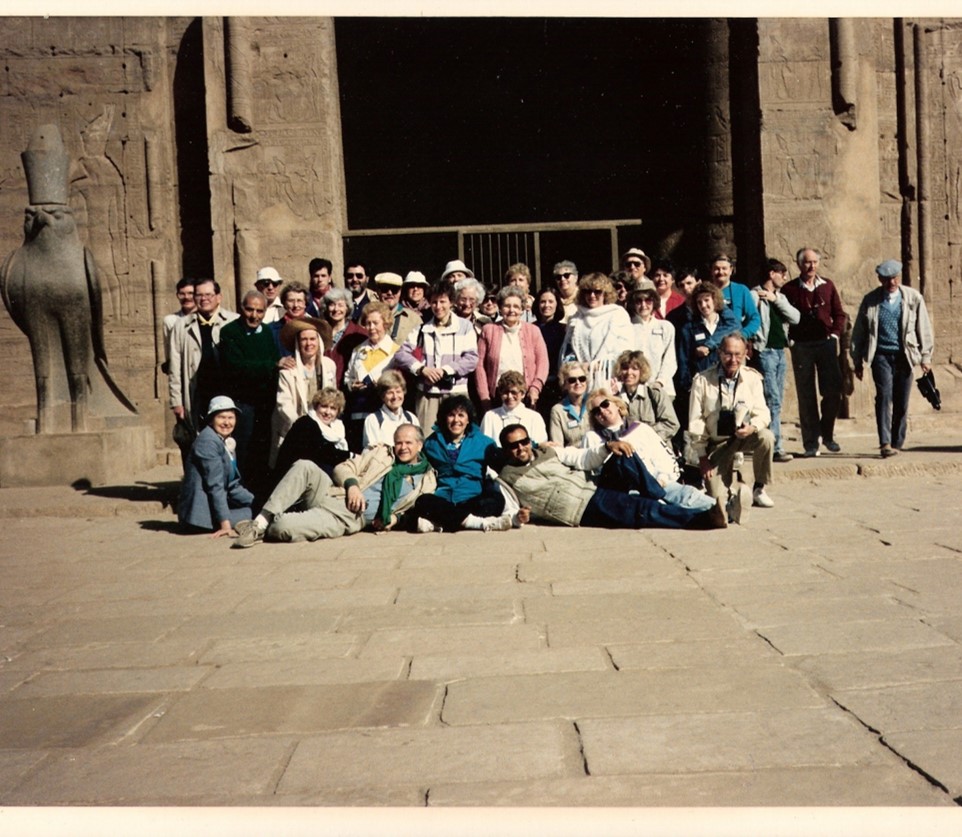
The college also became more heavily involved in cultural diversity. During faculty development periods in January and May several all-day seminars and workshops were conducted on various diversity issues on recognizing cultural differences and dealing with students representing different cultural backgrounds.
Management development was an important focus in promoting and enhancing management skills among the administrative staff and among faculty who had supervisory responsibilities. Various educational leaders were brought in as guest speakers, such as John Roueche and Russ Baker, both at the time from the University of Texas.
By February 1990 the college had established the HCC Alumni and Friends Association. Over 300 former students joined the association. The first officers of the association were Judi Neyman, secretary (class of 1979), Glenda Kruger, vice-president (class of 1980), William Manning, president (class of 1986), and Kathy Kershesky, treasurer (class of 1988). The advisor was Mary Armiger, who served on the HCC Educational Foundation Board, and Sandra Harriman who was Director of Development and Alumni Relations.5
Spring 1990 credit enrollment was positive. It was higher than the previous fall’s by 80 students – 4,278 vs. 4,198. As in past semesters there were more females than males, but not as it had been in past semesters when females accounted for almost twice the number of males, and the racial/ethnic mix was pretty much the same, with “Blacks” constituting a little over 13% of the student population, Asians almost 4%, and Hispanics at about 1.5%.
After rigorous preparation, the participation of many college personnel, and the research and production of documentation that was necessary, HCC was accredited for another five years, up to 1995. Not the least of HCC’s accomplishments was that the nursing class of 1990, with 27 graduates, had a 100% pass rate on the National Council Licensing Exam. “Only 4 out of Maryland’s community college nursing programs achieved a 100 percent pass rate anytime during the past five years, according to State Board for Community College data.”6
In the summer of 1990 the Columbia Festival of the Arts was held between June 22 and July 1, and the college’s facilities were used for various presentations and performances. There were nine major concerts and performances in the Smith Theatre during this festival, and several HCC employees served as technical or volunteer participants. HCC’s president, Dwight Burrill and Trustee Ron Carlson were on the festival’s board of trustees.
That same summer the Faculty Evaluation System (FES) and Promotion requirements were reviewed. This was an ongoing process at the college. The FES had been introduced in the early “70’s, and it was complex ; there was a continuing concern on the part of the instructional administration to maintain an accurate method of assessing faculty performance and, because of the high level of detail in this program, there was faculty concern that the evaluation should be fair and consistent, and there were two parts to this. On the one hand there were faculty who agreed that accurate assessment was a perfectly understandable position for the college to have, but the level of detail was not necessary. On the other hand there were faculty who had the understanding that considerable precision was necessary and a faculty member’s time on various responsibilities should be specified so that faculty would not be overburdened. Thus, in the minds of some the system had a lot of “nickel and dime” detail to it. The initial review came out in a 22 page document in May.7 The recommendations that came out in July were incorporated in an 11 page memo and dealt with teaching load calculations, promotion regulations, and other recommended changes.8 The point of this is the complexity of the Faculty Evaluation System, promotion regulations and, perhaps just as important, the time and effort that was required on the part of the instructional administration and faculty to review this entire system periodically and make changes that ranged from minor details to major changes that required just as many, if not more, details.
The fall 1990 credit enrollment had a credit headcount of 4,447. This was up from the prior fall by 249. Most of the comparisons of median ages, gender, and race stayed pretty much the same. There were 1,709 males to 2,738 females, and the median ages were 24 for males and 27 for females. The racial/ethnic mix had 4.8% Asian, a slight increase over the prior year, 12.1% African American, a slight decrease, 1.4% Hispanic, about the same. A little over 2% were American Indian and others, and “White” was 79.5 %. The distance learning program, if one could truly call it that, was telecourses. Its enrollment for the year was at its highest with 730 students. On-line courses had not yet appeared on the scene. 1990 ended well with the college continuing to serve students and the community.
1991 WAS QUITE A YEAR
On January 16, the beginning of the year, the United States and the coalition forces that were allied in Desert Shield bombed Baghdad since Iraq refused to leave Kuwait; this was the beginning of Desert Storm. By the end of the year the Warsaw Pact ceased to exist and on December 25, Mikhail Gorbachev resigned as president of the Soviet Union and with all the Soviet republics having spun off from the union, the Union of Soviet Socialist Republics dissolved. It was no more. Even though the relationship between the U.S. and U.S.S.R. had improved greatly under Gorbachev, still the end of the Soviet Union was seen as a positive thing. No more Cold War.
In Howard County the last of Columbia’s villages, River Hill, opened and coincidentally the very first family to move into that village was Roger Caplan and his family, and he would subsequently be on the college’s Board of Trustees. It was also the year of an event that was unique to Columbia, the Columbia Forum’s first Great Cardboard Boat Regatta. This was a competition where residents would construct boats of all kinds of designs and shapes made of cardboard and would launch them in Lake Kittamaquandi. There were 47 boats that participated in the event. The boats that lasted longest were the winners.
Things were happening at the college too. Walter Bumphus, who had been Vice President and Dean of Student Services since 1979 left to become the President of a community college in Texas and Maureen Kelly who had been his assistant became the acting VP of that area, but was informed by the president that as an acting VP she would not be eligible as a candidate for the permanent position. A search would be commenced for a permanent appointee. The Vice President and Dean of Instruction, Peter Ku, also left to become president of a community college in Seattle and he was replaced on an acting basis by Mark Canfield who had been a sociology professor. And a search for a permanent VP/DOI would begin. HCC continued to be the stepping stone for presidencies.
The college’s Office of Research and Planning (as it was called then) conducted a “survey of employers of HCC graduates to see how well graduates of the college are prepared for their chosen fields. The results of the survey were positive and “the overwhelming majority have consistently said that they would hire another HCC graduate and would encourage other employers to do so.”9 The college also did well when county residents were surveyed about how they viewed the college and what it had to offer. “HCC received its best marks for location (92% “excellent” or “good”), its general reputation (72%), tuition costs (71%), and course and services for adults (71%).” In addition, “HCC’s ratings took a generally positive turn in the past five years.”10 This clearly has some importance since in prior years, especially in its early years, the college was new and with all the surrounding name college’s and universities there were times that HCC, and other community colleges, were sometimes thought of as the 13th grade of high school and, as the author had heard “high schools with ashtrays.”
The spring credit enrollment was 10 students higher (4,457) than the fall 1990 credit headcount (4,447), and that was contrary to the usual pattern of spring enrollments usually being lower, and spring 1991 was 179 students more than in spring 1990. The other data, such as the male/female, racial/ethnic, etc., ratios did not show any major changes that were worthy of remark, and the median age of the college’s students stayed steady at 26 as it would for several more years. But, what is worthy of remark is that the college just kept on growing. A very clear example of this growth was the waiting list of students who wanted to get into the nursing program. Toward the end of the year an evening nursing program was developed and it was recommended that the program go into operation in the fall of 1992.11 But with success came challenges. The college’s growth also meant increases in necessary expenses; more staff and other resources. The Board of Trustees accepted the president’s recommendation of a tuition increase of $3 per credit bringing the tuition to $47 per credit hour.12 So, fall ’91 was going to cost students more.
Well, the credit headcount for fall ’91 was 4,883; it was 436 students higher than the prior fall. The students kept coming. And the nursing program was leaping forward. It was the third largest at the college with 430 students. The two bigger ones were two transfer programs, Arts and Sciences with 664, and Business Administration with 531. The more that the enrollment increased meant more faculty, staff, and less space. So, it was time to think about addition to the facilities. The college received a plan from a local architectural firm, and it was an interesting one.
“HCC has been constructed in a series of attached linear structures without creating a sense of a central entrance to the college. The lack of a central core and a defined sense of entry, led us to the concept of creating an axial scheme for the classroom expansion between the existing Administration Building and the Nursing Building that would not only centralize more of the classroom space, but also offer a sense of entry and identity for HCC.”13
True, the college was laid out in a linear manner; although it was actually L-shaped with the Library Building (which was the original and only building when the college opened in 1970) as the leg of the L, and then one long structure of Nursing Building, Administration Building, and Smith Theatre. The “axial scheme” proposed by the architects is shown in Appendix D. The proposed building would have four floors that would have a total of 32 classrooms and 25 faculty offices. While the plan was interesting and would create a cohesive single facility of the college it was not pursued after 1992.
REORGANIZATION
In March 1991 Burrill “updated the board of the current college reorganization that was initiated because of the administration’s desire: to return administrators to teaching positions, to improve the full-time/part-time mix, to eliminate a layer in the organization and to promote new leadership within the institution. This process was a‘bottom-up’ reorganization.”14 In that meeting Trustee David Campbell expressed concern with regard to the reorganization. “He felt that the reorganization had policy issue implications and that the board should have been involved in the process from the beginning.15 While this was a statement by one board member this may be a telling moment in relationships between the president and the board. In reviewing past board minutes previous reorganizations, and there were several, never invited such a comment and in some cases did not even appear on the Board’s agenda. Further, “the board discussed the possibility of the division chair positions being ‘acting’ for one to three years. This concept could provide more opportunities for minorities to move into academic leadership roles. D. Burrill indicated that he would take this matter under advisement.”16
The reorganization abolished most of the Associate Dean positions, with the exception of the position of Associate Dean of Continuing Education, and organized the instructional area into more traditional divisions. The structure that was to be changed was the one that had Associate Deans and coordinators under them. The general structure of this organization may be seen in the chart on page 45 of Volume II of HCC’s history. The new organization would have division chairs as 12-month salaried appointments with reviews of their appointments and consideration of other faculty applying and “running” for these positions every few years.
The structure was quite traditional. Even though the divisions were multidiscipline ones, the disciplines were closely related. The Science Division included biology, chemistry, physics, geology, and engineering. The Social Sciences had anthropology, economics, history, psychology, and sociology. If HCC were a much larger school these would probably have been departments within divisions and, indeed, by having coordinators within the divisions, the school did have “mini” departments.
The individuals who became division chairs moved, as already mentioned, from being 10-month faculty to 12-month administrators with faculty rank and who had supervisory/managerial responsibilities over schedules, budgets, and faculty within their divisions. It should be noted, however, that there are those who see division chairs as faculty with administrative responsibilities.
The student services area was also reorganized as the positions of Associate Deans were abolished in that area too. Some of the positions were renamed as Director positions. Never a dull moment at HCC.
1992
Here is the world that we lived in during this year.
Russia’s president Boris Yeltsin announced that Russia would no longer target U.S. cities with nuclear weapons. That was certainly good to hear. The Maastricht Treaty was signed that founded the European Union; so, Europe’s countries would get along better with one another, but the Socialist Republic of Yugoslavia began breaking up into Serbia, Slovenia, Croatia, and Bosnia. The latter would become a major international problem with tragic events in that area.
In the U.S. Microsoft released Windows 3.1, and something new was happening. The Washington Post carried a cover article that stated that “there are clear signals that yet another gizmo is about to invade the American family consciousness.”17 While the article used the terms “beeper” and “pager,” the article delved into all the communication possibilities that included much of what we have today. In November Arkansas Governor Bill Clinton won the presidency over the incumbent George H.W. Bush and third party candidate H. Ross Perot. A few notable deaths included Sam Walton of Wal-Mart, the sci-fi author Isaac Asimov, and Commodore Grace Hopper, one of the pioneers of computer software and a graduation speaker at one of HCC. In the world of entertainment Johnny Carson retired, a popular film was “Sister Act” with Whoopi Goldberg, Miley Cyrus (AKA Hannah Montana) was born, and the best picture Oscar went to “Silence of the Lambs.”
By 1992 the county’s population was approaching 200,000 and the college was growing too. Howard was an educated county. According to the 1990 U.S. Census the county was 8th nationally in adults aged 25 or over with college degrees, and 15th with adults aged 25 and over with advanced degrees. So, higher education was a value in the county.
The spring semester at HCC saw a student credit headcount of 4,607, 150 higher than the prior year’s spring enrollment. Minority students accounted for a little over 20% of the credit student population, up by almost 2% over the prior spring. In May the Alumnus of the Year was Raquel Sanudo who was the Chief Administrative Officer for the Howard County Government. Sanudo had graduated from HCC in 1979.
Several programs emerged in that year. Burrill had the idea that there should be a selective program for high achieving high school graduates, and the program would be open only to students who would be graduating from high school in that year. Students who were already at HCC or were transferring in from another college or had graduated from high school several years earlier, were not eligible. Between the Admissions Office and Dr. Jerrold Casway, who was appointed to direct the program, planning began on the program that was given the working title of “Young Scholars Program.” High school students who were graduating and wanted to be in the program had to apply and a committee reviewed the applications. Some of the criteria for entrance into the program included a high school GPA of 3.2 or a 3.0 in high school honors courses, or a combined 1,000 SAT score,18 letters of recommendation, data on the students’ extracurricular activities, and a narrative statement of interest by the student. The process was rigorous, but flexible. Based on the total application package that a student submitted, a student did not need to meet all the quantitative requirements of GPA and SAT. They could have lower scores in one or the other as long as other elements of the application demonstrated that the student would be a good choice for the program. This was the planning year and its official start was to be fall 1993. So, there was almost a year and a half of planning. In this planning stage the permanent name of the program was recommended by Professor Valerie Lash, and it was accepted. The program would be known as the James W. Rouse Scholar Program. The choice of the name was an excellent one given James Rouse’s creation of Columbia and the standing that he had in the community and, indeed, nationally. A major part of this program was to develop agreements with four-year schools to accept graduates of the Rouse program, and this indeed had begun at the very start of the program and was quite successful, thus giving HCC Rouse students a clear and definite path to some prestigious universities.
Another program that was introduced was the “Summer Honors Program for High School Students.” It offered HCC’s college-level courses to students who would be going into their 10th, 11th, or 12th year in high school. Twenty two high school students enrolled in the first year. Three courses were offered; History 121, Biology 101, and Humanities 101. Six of the students took two courses. The program was coordinated by the author and it continued each summer for five years.
The Continuing Education Office maintained its activity in international education and trips. A community trip to Italy was developed, coordinated by Joann Hawkins of the Continuing Education Division and led by Helen Mitchell, Associate Dean of Continuing Education. It was a two-week excursion that included Venice, Florence, San Gimigniano, Sienna, and Sicily. The total cost was $3,125. Through the Continuing Education Division the college began to offer credit courses to non-credit students. The thinking and the plan was to allow credit courses to be co-listed that would “allow a student to enroll in a credit course and receive continuing education credits (CEU’s) instead of credits to be applied toward a degree.”19 This program was an important contribution to the community in that it presented a more flexible approach to courses, offered more courses for a person to choose from, and generated more income for the college.
In the Nursing program it was the second year in a row that the nursing students had a 100% pass rate on the National Council of Licensure Examination for Registered Nurses. Not bad! The demand for nurses led the college to develop an evening nursing program to accommodate the growing number of applicants to the program. It would begin in the fall 1992 semester.
In addition, there were a few kudos; Professor Russ Poch received the 1992 Maryland Association of Science Teachers Award for Excellence, and Professor Linda Johnston received the 1992 award as Health Educator of the Year by the Maryland Association of Health.
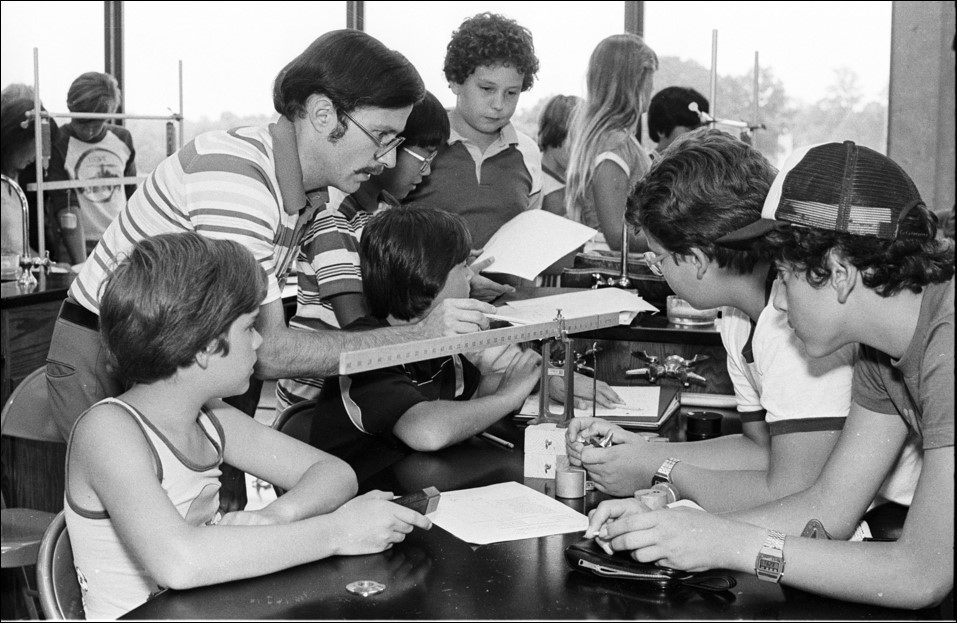
The college developed an “Image Enhancement Plan” that was coordinated by Randy Bengfort ,the Director of Public Relations and Marketing. Part of the plan was “to upgrade the ‘visual identity’ of HCC. As part of the college’s effort to create a visual identity, it was determined to develop a new logo.”20 Prior to the development of this logo there was none until 1978, and from that time until 1991 there was a circular emblem of the college with a linear map of the county inside of it and, inside the county “map” was a tree that was clearly the “people tree” of Columbia (see Appendix E). The final version of the new logo was “a heraldic shield with a lion holding a lamp and elements of the Maryland flag from the Calvert family coat- of- arms.”21 There were a few recommended changes to the logo. First, “the lion was revised so that it held a lamp of learning to symbolize education. Second, small crosslets in the shield (part of the original Howard family crest) were replaced by larger crossbars from the Maryland flag, which were taken from the Calvert family crest.”22 The part of the design of the logo that had the name Howard Community College, with the underscored letter in “Community” did not have any meaning other than a design feature; although Randy Bengfort did recall that some participants thought that this underscoring emphasized the college’s commitment as part of, and to, the community.23

This project was presented by a consultant, but had the participation of student and community focus groups also. The transition to a new logo meant the printing of new letterheads, envelopes, etc. “The Board encouraged the college to be conservative in the implementation of the new logo and not to toss out existing paper, etc. that has the old logo on it.”24 A few months later, in May, the Board of Trustees approved a $42,943 contract to a company to implement a system of campus signage.25 Over the past several years there were various signs put up around the college and they were in various styles and, based on their age, in various stages of disrepair. So, signs that had a consistent style, pattern, and standard were thought to be necessary.
Plans for the new classroom building mentioned earlier were put on hold in 1992; however, the need for space was solved at least partially by the renovation of two floors in the Hickory Ridge Building that would be used by the college. College expenses were still rising and the Board approved a $5 per credit increase in tuition. An in-county student would now be paying $58 per credit. That was getting high, but the college’s commitment to helping students was also high.
The college’s annual equestrian event was becoming more popular, not only with the community, many of whose residents came to watch the events, but also with the equestrian community that had participants who were on national, international, and Olympic teams. The Grand Prix income for 1992 was $164,450. This was $75,000 more than the prior year. That is remarkable, and students would benefit by having a very viable scholarship program.
There was another element to the college’s commitment, and that was a dedication to quality performance in teaching and in the administration of the college, and in the quest for improvement where necessary and desirable. Thus, enters Total Quality Management/Continuous Quality Improvement (TQM/CQI). The origins of this program began in the mid-1980’s in American corporations. While it is arguable that it was somewhat a descendant of Management by Objectives of the ‘60s and ‘70’s, there was a major difference in basic philosophy and that had to do with quality as a very conscious and deliberate part of a college’s planning and execution. As a start there was a fundamental position that had to be taken. “If it cannot be described, it by definition cannot be improved; hence a major preoccupation of TQ(M) practitioners lies in identifying core processes and determining exactly how they work.”26 As more corporations adopted this approach and were apparently successful and pleased with results, the United States Congress “was so impressed with the potential of the quality movement that it created the Malcolm Baldridge National Quality Award in 1987 to recognize companies with exemplary quality practices.”27
Schools became involved in this program. Over the next several years businesses encouraged colleges and universities to become involved by providing start-up funds and by offering seminars and workshops on the topic on college campuses.28
HCC’s entry into this was in 1992 with the President and the Board of Trustees being trained in the processes of the program. While the data are not complete as to the amount of training, there seem to have been several sessions that would even go into 1993. Indeed, there is a short entry in the Board Minutes stating that “one last TQM session must be scheduled with the board.” 29 Thus, it is clear that there were several sessions that involved the Board’s participation.
’93 was “OMG!!”
President Bill Clinton began his first term. He named Janet Reno to be the first female Attorney General. The Nobel Peace Prize went to Nelson Mandela and Frederick deKlerk. The World Wide Web was created and everyone watched “Sleepless in Seattle” and felt good.
HCC’s spring credit enrollment of 4,789 was 182 headcount higher than the prior spring’s. The enrollment of Asian students was slowly notching up. Less than a decade earlier Asian students accounted for 2% of the total credit student enrollment. By spring 1992 they were 4.5% of the total.
The college’s FES/MBO system was still in operation, and this was also the year of TQM and CQI, in a number of ways. The college newsletter, Campus News stopped being published around this time and a new “newsletter” came out. It was called On the “QT.” It is not clear whether there was a planned replacement of one newsletter by the other or whether the Campus News had simply run its course after a good period of publication of over 10 years. Nobody seemed to remember why it stopped being printed. The first issue of On the “QT” was in August, although things had been gearing up a year before, as mentioned in the last chapter.
In April a major organizational assessment was made to establish a plan for training the college staff in TQM. This assessment consisted of interviews, focus groups, and identifying cross sections of the college community for training. The result of all this was given to the consultants that the college hired, and they developed the training program. Lest it be thought that this was a totally administrative enterprise, the first “college-wide TQM awareness training was conducted on campus,”30 in May and there were three students in this two-day training workshop and 15 HCC employees, five of whom were faculty. The following month a steering committee was organized that consisted of representatives of each of the college’s constituency groups.
Four areas were identified to be the first in the continuous improvement project; Academic Advising, Evening and Weekend Services, Computer Technology Program, and Programs for Support Staff and Paraprofessionals.31
The coordination of this entire project was assigned to Maureen Kelly. She had been at HCC for a number of years, having been hired in 1979 as Registrar. By 1982 her title had been changed to Director of Records and Registration. She was in this job for several years and in 1987 she became the Assistant to the Vice President of Student Services (at the time the VP was Walter Bumphus), and upon his departure from HCC in 1991 to move on to a presidency, Kelly became the acting Vice President and, as stated above, with the express understanding that she would not be allowed to apply for the permanent position.
In August Dr. Kenneth Atwater was hired as Vice President of Student Services. He and Bumphus had known each other when they were students at Murray State University in Kentucky. Kelly, who had been acting Vice President of Student Services in the interim between Bumphus and Atwater, was given the title of Vice President for Quality Management,* and she and Mary Collins, the Office Supervisor of the Vice Presidents’ area, became the co-editors of On the “QT.” The official name of the TQM program became known as the Howard Community College Quality Quest, the abbreviation for which came to be known as HCCQ2.32
While the administrative side of the house was progressing with the implementation of TQM, there were a number of exciting developments in other areas of HCC.
The college’s theatre program needs to be mentioned because it is not only part of the life of the college but also because its development, evolution, and importance to the college and community is significant.
In its earlier years the theatre program was what is called a presenting organization. This means that the college would invite actors, acting groups, musical groups, and such to appear at the college. Thus, in the formative years the theatre had the actor Vincent Price perform in the one man play about Oscar Wilde. William Windom did his one-man show on Thurber, and Kevin McCarthy did “Give ‘Em Hell, Harry,” which was a one man show about President Truman. There were also performances by the drummer Buddy Rich and the Washington Ballet. “We were primarily a presenting organization where we would present theatre, touring theatre companies, touring dance companies, or we actually had a music series as well, jazz. And we would produce one show a year, generally speaking.” 33
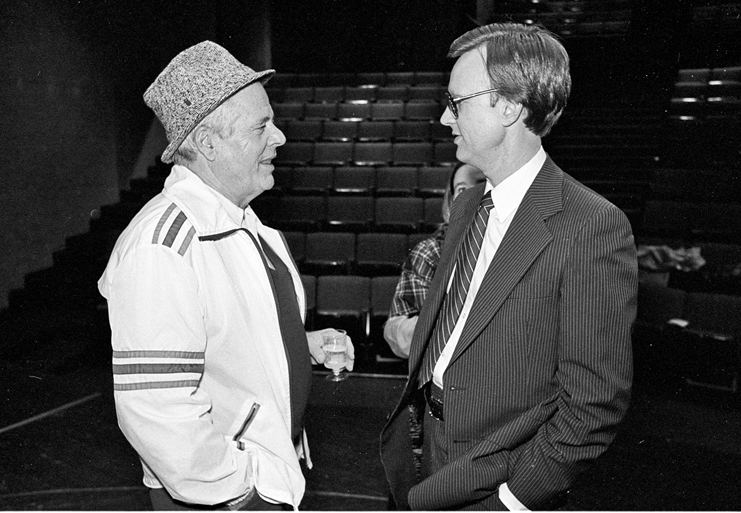
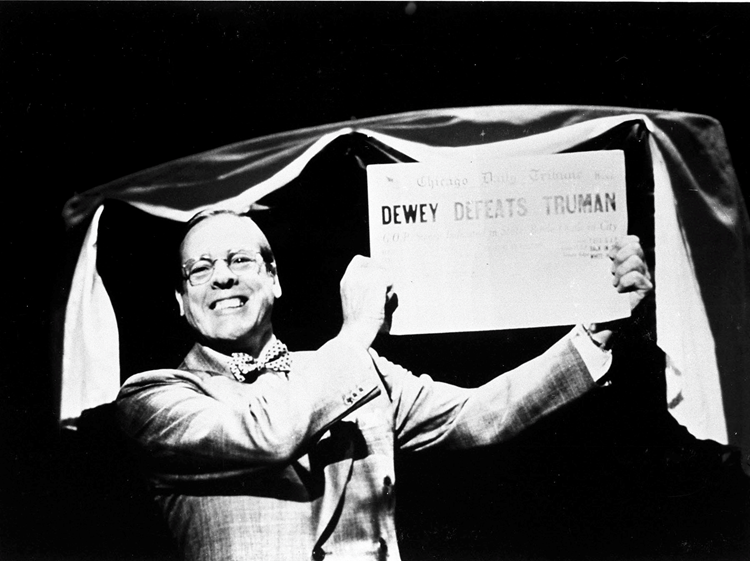
There were also other theatre events that were “primarily community theatre, though. It was not student theatre, it was community. There were not professional actors. Occasionally, we would bring in a . . . professional actor to be the guest artist.” 34 In the William Albee play, “Everything in the Garden” there were no professional actors, strictly community residents. But, there were also some productions that were home made; that is, where the director and actors were HCC staff. The play “Whose Life Is It Anyway” included (in alphabetical order) Marion Durkan of the Nursing faculty, Donna Kirkley of the English faculty, Valerie Lash of Humanities, and Vladimir Marinich who was Chairperson of the Business Division at the time. The director of the play was Jay Drury who was director of the theatre.
Upon Drury’s resignation Valerie Lash was appointed to take charge of the theatre program. The theatre program got a good shot in the arm with Lash’s plan and Burrill’s approval. This was to establish a repertory company in residence at the college. This was no easy matter. It meant that the program would have to have professional actors who were either members of Actors’ Equity or were candidates for membership. This organization is basically a labor union that represents actors and stage managers and negotiates working conditions and how performers would be paid; so, an entirely new budget process was required to handle all of this. Thus, the college’s theatre program really moved up a notch and, while student and staff performances were still done, the college had a professional theatre operation in action. If that is not enough, read on!
There are a few facts that make the theatre program at Howard Community College remarkable. The college’s equity theatre in residence is the only community college in the United States that has that distinction. Further, HCC is the only college, including four-year colleges and universities, in Maryland that has an equity theatre in residence. This was, and is, one of the main features that makes HCC truly a cultural center in the community, even in the state.
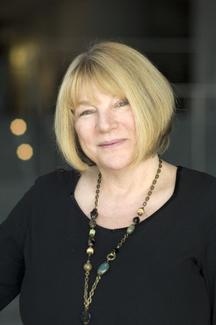
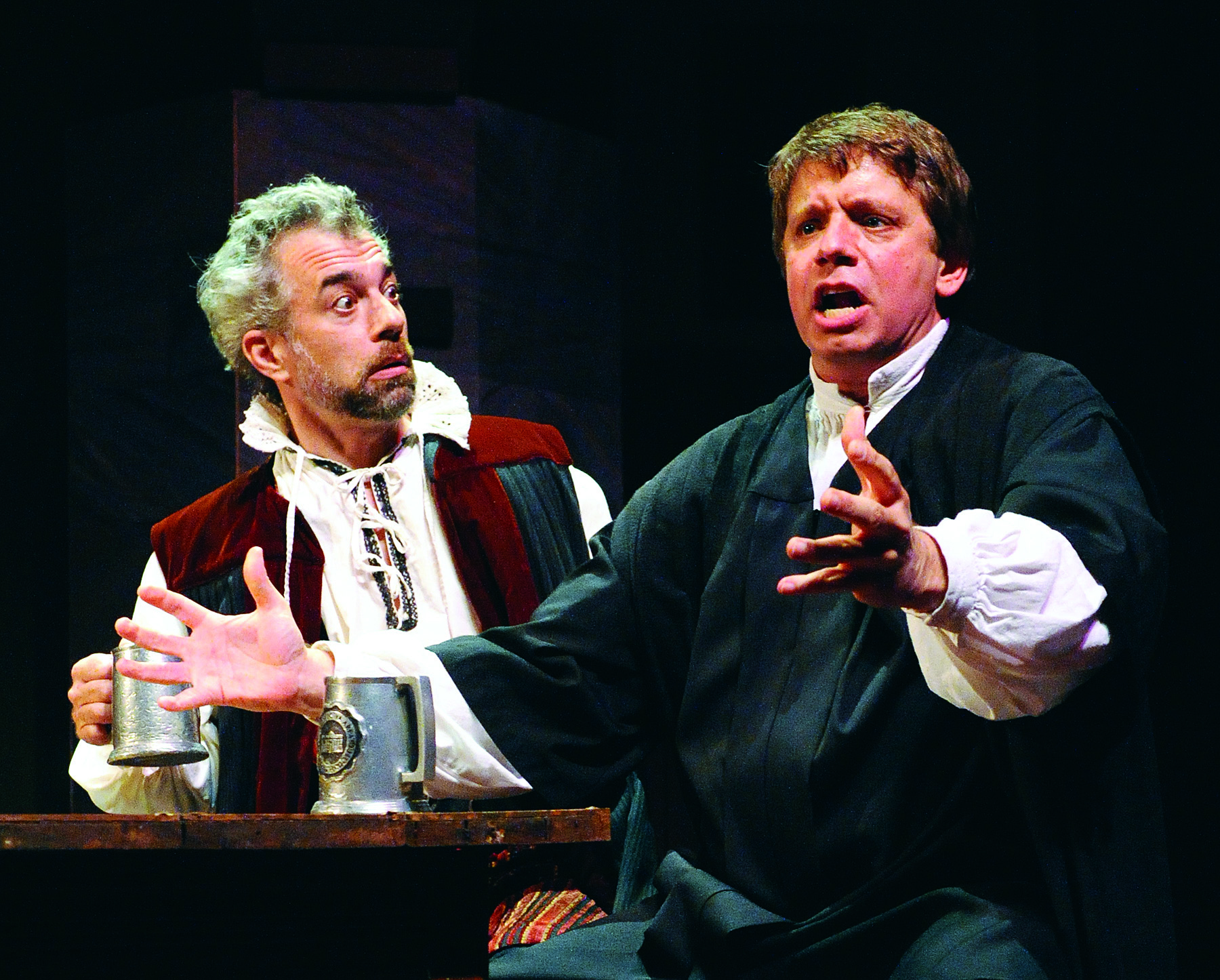
The fall 1993 semester was the start of the Rouse Scholar Program. The initial enrollment had 25 students who were carefully screened. The application process was a selective one and a committee consisting of the newly appointed director, Dr. Jerrold Casway and representatives from Admissions and Counseling went through the applications. They were looking for capable and high achieving students; and the program was open only to students who had just graduated from high school. It was a pretty tightly identified cohort group. Its initial success was due in large part to the prior year’s planning and the active support that was given to the program by Burrill. Not only that, but the promotion and recruiting that were done by the Admissions Office proved quite effective. The operation of the program was under Dr. Jerrold Casway, the director, who did planning, scheduling, and who also taught one of the courses each semester that was restricted only to Rouse students, and it should be pointed out that there were several courses that were restricted to Rouse students only. Some of these were Casway’s two history classes, the introductory psychology and sociology classes, a world literature class, and a special seminar for Rouse students. In order for Rouse students to stay in the program they had to maintain a 2.5 GPA. Casway’s rationale for a GPA at that level was that it was appropriate because of the depth of the “honors-level” courses within the program even though their were other courses that the students had to take that were not part of the restricted “Rouse” courses.35 The day to day activities of the program, such as monitoring student attendance, participation in Rouse activities, coordinating such activities and “chaperoning” the Rouse students on various outings and retreats was done by Margaret (Peggy) Armitage and Shawn Bingham. Given the special nature and conditions of the Rouse program, Casway noted on a number of occasions that in effect he was “running a college within a college,” and as the program was explained above, one could make somewhat of a case for such a statement.
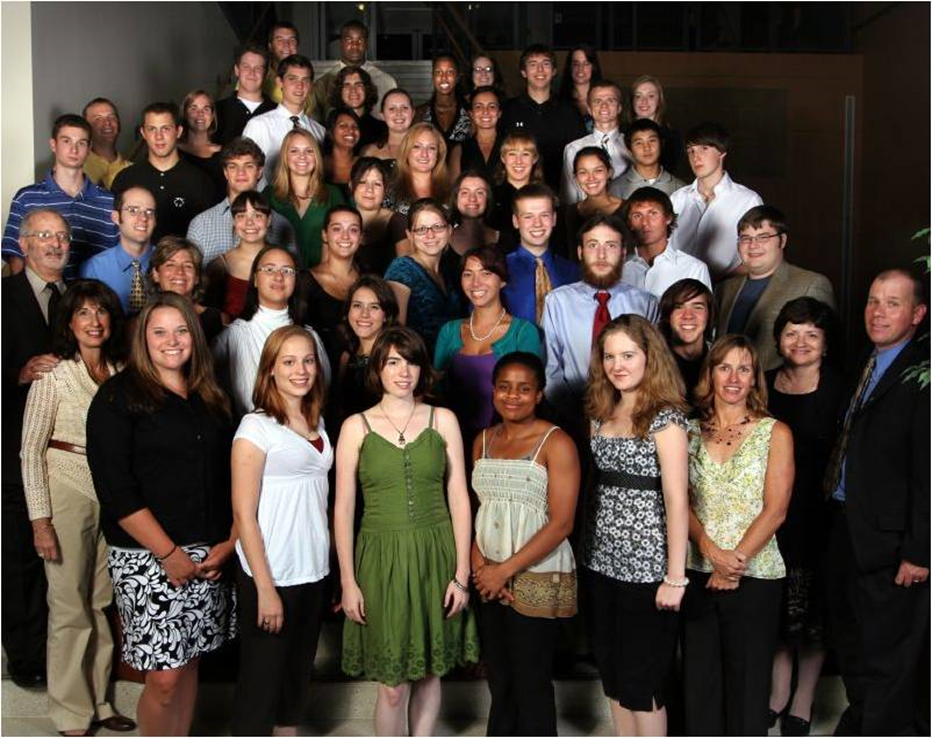
The fall semester also moved the college into the world of international education. The college formed a sister college agreement with Xiangfan University in China.36 This was the beginning of an active effort to establish ties with colleges abroad.
By the very end of the year the college was in the Gateway Building and its furnishings of classroom tables, computer tables and chairs, CRT projectors and rear screen projection came to $283,278.37 This was to become a major satellite campus of the college.
Was ’94 a Quiet Year? Maybe Not.
So, what was going on in the world and around town? Nelson Mandela was elected president of South Africa. The Soviet Union invaded Chechnya and Serbs attacked Sarajevo. In the U. S. Newt Gingrich became the Speaker of the House of Representatives and there were some notable deaths. Richard Nixon and Jacqueline Kennedy Onassis passed away, as did the entertainer Cab Calloway. O.J. Simpson was arrested for the murder of his wife and one other person, and the World Series was not played because of the baseball players’’ strike. Whitney Houston’s song “I Will Always Love You’ was the record of the year.
Closer to home Charles Ecker was in his third year as Howard’s County Executive and Columbia’s population hit 79,000.38 River Hill High School opened, making it the 10th high school in the county.
Student enrollments in the spring semester, as seems fairly usual, were a bit lower than the previous fall’s and just a bit lower than the prior spring’s,39 but the minority student population was at 23% of the total credit students, and the Asian student population at the college was slowly notching up again; it was now at 6% of the total credit students.
At the start of the year there were 81 full-time faculty, more than half of whom were at the two higher faculty ranks and there were 40 employees in the administrative ranks. In the college catalog Chairs were classified in the faculty category, whereas when there were Associate Deans several years before, they were classified as administrators even though they had faculty rank. Thus, there was an ambiguity regarding the chairs and two chairs acknowledged this to the author.
There were some changes that began to show themselves around this time. One that was noticeable if one paid attention to the organization charts is that the Dean of Instruction’s title changed. Burrill had a sabbatical leave and he chose to leave one of his team in charge while he was away. Dr. Carol Copenhaver, who was Vice President and Dean of Instruction, was now Senior Vice President and Dean of Instruction. Upon Burrill’s return that title remained.
TQM, or CQI, or HCCQ2 continued with further study, analysis and clarification of how the college might implement it for the long run. A budget of $15,000 was developed for the first year, a major part of which would be used for training. “Personnel costs will be assumed within the Office of Planning and Evaluation Budget. Planning and Evaluation Office personnel (excluding the director) will devote at least half of a staff year towards the CQI function.”40
In the academic wing of the house there were changes that were quietly but definitely happening. The commitment to the “systems approach” had waned. Faculty were no longer required to be trained in developing their courses with specific outcomes-oriented objectives for each unit of the course and in tying exams to the objectives. This was not an institutional decision; rather it was simply the decline of importance in this area. There was an increased emphasis at this time in the use of technology in the classrooms and this seems to have overshadowed the pedagogy of systematic instruction as it had been practiced at the college since its earliest days; hence a new direction was taken in the academic side of the college.41 As a bit of evidence of this, during the spring 1994 Faculty Development Workshop week there was no training in the “systems approach.” There were the usual meetings, to be sure, and the workshops were CEI training, several writing intensive meetings, a workshop titled “Dealing with Prejudice, “a session and panel discussion following a presentation on the Holocaust Museum, and a workshop titled “Dealing with Anger.”
There was also a change in the requirements of faculty who sought promotion. The requirement was no longer that a faculty member had to show a continuum of development in one course as they got promoted through the ranks; rather a faculty member could now have greater choices. The Faculty Handbook now read:
Significant course or curriculum improvement project that strives to improve student learning including these elements:
- Evidence of innovation
- Design and implementation of the project
- Evaluation of the project, including the collection of data
In some instances the division chair may approve a substitute project related to program improvement or institutional
enhancement.42
The decreased emphasis on the “systems approach” and the changes in the promotion requirements to include projects of “institutional enhancement” changed the faculty culture at HCC. It allowed greater flexibility to faculty and to chairs and it opened the possibilities for faculty to explore projects that went beyond the highly focused pedagogical approach to student learning,43 that had been paramount in the past, but the decline in the college’s commitment to this program did not give new full-time faculty as good a grounding in pedagogy, and for new adjunct faculty perhaps even more so.
Another area of change, or innovation, if you will had to do with funding. In the late spring the President and Board of Trustees were looking into additional sources of funding for the college. Burrill reported to the Board that “he does intend to spent (sic) an as-yet undefined amount of time off campus searching for potential sources of revenue for HCC. To help the day-to-day operation of the college, he informed the board that as of July 1, 1994 he will promote Carol Copenhaver, vice president and dean of instruction, to senior vice president.”44 Burrill’s activities in this area would go on for several years, and this project would become known as the “Fourth Source.”
Late summer was Grand Prix time. The college’s equestrian event was nationally known by now and the support from the community, especially from the Bolduc family, helped considerably. This was the best year ever in terms of fund-raising. It was the biggest- ever Grand Prix with an income of $228,928, almost $59,000 more than the prior year.
The fall 1994 semester saw a dip of about 60 students, but minority student enrollment went up and, although slightly, it still went up. Asian students were at 5.7%, African American were at 16.5%, and Hispanic were at 2.1%. So, from the prior fall of minority students accounting for a little over 21% of the credit student body, they were now over 24%. This trend would continue.
1995, a Year of Anniversaries
As always, a lot was going on in the world, in Howard County, and at HCC. The fighting in Bosnia and Croatia seemed to come to an end, but elsewhere peace was threatened as the Israeli Prime Minister Yitzak Rabin was assassinated by an Israeli extremist. In the U.S. the Million Man March in Washington, D.C. reminded us again of Martin Luther King’s not yet fulfilled dream, and the murder trial of O.J. Simpson with its undercurrents of racial division was nervously watched throughout the summer.
The best motion picture Oscar went to “Forrest Gump,” and the best song was “The Streets of Philadelphia” from the film “Philadelphia.” The Rock and Roll Hall of Fame opened in Cleveland. So much for entertainment. Some notables passed away in 1995; the sportscaster Howard Cosell, New York Yankees star Mickey Mantle, and Jerry Garcia of the Grateful Dead.
The college was 25 years old; but 25 years young is a more accurate and better way of expressing it. What did the school’s campus look like at 25? There were seven buildings; The Library Building, or the Main Building because it was the first and only structure when the college opened in 1970 (it would later be known as the Clark Building), the Nursing Building, the P.E. Building, the Administration Building (later named McCuan Hall) and Smith Theatre, the Hickory Ridge Building, the Science and Technology Building, and the Student Activities Building and Plant Operations facility.
Student enrollment was growing and the fall semester had 5,130 credit students. The college broke 5,000! As in all the prior semesters there were more female students than male, about three females for every two males. The median age of all female students was 28 and for males it was 24. HCC’s minority student population was almost 26% of the total credit student population. It had been edging up regularly. The two transfer programs with the biggest declared majors were Arts & Sciences and Business Administration. For occupational programs, the two big ones were Nursing and Business Management. The Rouse Scholar Program proved to be attractive and became successful very quickly.
1995 was also the 50th anniversary of the end of World War II. The author, who had returned to faculty status after serving as Associate Dean for Instructional Support Services, wanted to acknowledgement, or celebrate if you will, and commemorate this event. The Library Director assisted in this project. The plan was to have two conferences/symposia, one to recognize the anniversary end of the war in Europe by having an event in May, and the second event would be in September to reflect on the end of the war in the Pacific. The dates were set and a number of public service announcements went out seeking individuals who were veterans of these two theatres of operation. The results were gratifying. World War II veterans of the several services responded and volunteered to be on various discussion panels. Thus, the May symposium had those veterans who served in Europe while the September symposium was for those who fought in the Pacific. The May event was in the cafeteria (aka the Galley).
The May symposium was half a day and panel discussions included tales of personal experience that could truly be described as touching. There was a veteran who was captured by the Germans and was sent to the P.O.W. camp that was the subject of the film “The Great Escape.” A veteran who had been a bomber pilot met for the first time a veteran who had been a fighter pilot and whose squadron flew escort for those bombers. A nurse recounted her experiences in caring for the wounded. There were a number of similar stories and there were over 30 veterans who attended as well as some college staff and students. Finally, there was a quite elderly Russian gentleman who had been in the Soviet army and who recounted his living through the battle of Stalingrad.
The September event had a different format. It was in the evening and it was in the Galleria. The college brought in a keynote speaker. Dr. Robert Maddox, Professor of History at Pennsylvania State University was a leading authority on World War II history, especially on the war in the Pacific and he was a major figure in the debate among scholars on the motive for using the atomic bomb at the end of the war. In addition to veterans of the Pacific theatre there were students and people from the community who attended.
The college celebrated HCC’s 25th anniversary with a picnic event at the Nixon Farm. This was a farm that catered such events and had been in the county for over 50 years. Dr. Alfred J. Smith, Jr., the college’s first president was there with his wife Professor Emeritus Bernadene Hallinan, who was the first Director of the Nursing Program, and five of the original staff of the college; as a matter of fact, the only five still employed there at the time. These were Daniel (Dan) Friedman, Donna Kirkley, Lawrence (Larry) Madaras, Vladimir (Vlad) Marinich, and Bruce Reid. A highlight of the day were performances by various college staff. Lynn Coleman and colleagues did a musical number as The Supremes, Jim Robbins led colleagues of the Student Services area in a number by the Village People. The Research and Planning Office worked up a skit that was a take-off on the joke wall from the TV comedy show, “Laugh In.” The “original five” faculty and Smith were the judges. The Planning Office won.
Earlier that summer the Continuing Education Office offered their summer program titled “Summer Sizzlers.” If the reader is not familiar with this program, here is the name that it was changed to shortly – “Kids on Campus!” Under the coordination of Sara Baum the program continued its success. That summer there were 38 courses offered, some of them having multiple sections. Everything (in alphabetic order) from Acting for the stage to Television Acting, African American Literature to Spanish, CAD to Windows, and lots more. That is not bad considering that the program started a decade earlier with just 4 courses.
The fall semester once again had more credit students than before; over 5,100, there were still about 3 female students for every 2 male students and the median ages generally held true with females at 28and males at 24. Minority students continued to increase and were over 25% of the total credit student population.
The Vice President of Student Services, Atwater, left the college in December. He had been at HCC a little over two years, and within the next two months, bringing us into 1996, two new Deans were appointed.
1996
In January President Bill Clinton gave his State of the Union Address and said that he wanted to connect every classroom in the U.S. to the Internet. Not everyone agreed. Some in Congress thought that the money would be better spent on teacher training. Later that year Clinton went on to win reelection, going up against Senator Robert Dole and the independent candidate Ross Perot. MSNBC began airing on TV. In September Oprah Winfrey announced the start of Oprah’s Book Club. Closer to home, Long Reach High School opened in 1996. The county now had 11 high schools.†
Two new senior administrators were selected in February at HCC. James Ball was appointed Dean of Student Services. He was Atwater’s replacement. Ball had started his career at HCC in the late ‘70’s as a Counselor. In the early ‘90’s he became the Assistant to the Vice President and Dean of Instruction, a position he held for a few years. The other position was Dean of Facilities Management. This was a new one and Dr. Mark Canfield was appointed to this job. Canfield had come to the college as a sociology instructor in 1972. He had risen through the faculty ranks to professor and when Dr. Peter Ku, who was the Academic Vice President, resigned to take a presidency in Seattle Canfield became the temporary Dean of Instruction at the college. Burrill’s confidence in Canfield’s ability to cross such divisional lines and handle a senior managerial position in this area was based on Canfield’s performance as interim Dean of Instruction and on his past experiences in home repairs.
It is hard to think about Howard County and Columbia without thinking of the college, and it is equally hard to think about Howard County and Columbia without thinking about soccer. Enter the Soccer Association of Columbia (SAC). SAC had approached the college several years earlier with a proposal that SAC build a complex of seven fields and lease them from HCC for a period of 20 years. The Board of Trustees had a number of questions that included “schedule of maintenance costs and who will handle them; parking impact; how will SAC control use of locker rooms: and are there considerations for concessions.”45 Communication on this matter between the college and SAC continued for almost two years with further meetings, some of which involved the community, but in January 1996 the college decided not to enter into an agreement with SAC. The latter’s final proposal,
“. . . would require a 15 to 20-year commitment. This length of commitment negatively impacts the college and the summer programs it offers that are different from other area camp options, which provide academic and sports alternatives for Howard County youths. SAC’s position would seriously undermine the college’s ability to respond to the changing educational interests of county residents.”46
This was a tough but reasonable decision that the Board had to make. On the one hand soccer in the county, especially in Columbia, was very popular. Howard County was a soccer powerhouse. Some of its high schools regularly defeated larger schools in the Baltimore area and won state championships, the neighborhood programs were very active and the travelling teams competed with nationally ranked teams. So, to turn down SAC was tough and who knew what disfavor it might have brought from the community; however, the long term commitment would put the college into a situation where it was not clear how HCC would be able to respond to changing circumstances in the future. While it did not have repercussions and it could have been a good relationship, the Board’s long-term view was the better choice.
There were other enterprising projects that the college was looking at. As mentioned already there was the “Fourth Source” and, indeed, the college was moving ahead in this area. The HCC Educational Foundation had been working on this and had a Fourth Source Committee. “The educational foundation intends to form a subsidiary of itself with its own board” and “the formation of this board should properly insulate the college and the foundation from tax consequences and other liability issues.”47 Thus was created the HCC Business Venture. It was not without its complexities. The Business Venture was to be incorporated as a for-profit entity,48 but not to be in a position where it would compete with other organizations where the Business Venture’s success might cause a competitor to lose employees. Did we mention complexity?
The spring and fall credit enrollments continued to be good, although the fall 1996 credit headcount dipped a bit. The Continuing Education Office’s offering of non-credit courses was doing well also with the FY1996 total registrations being 18,223. It is also worth remarking that ConEd’s summer program for youngsters had an enrollment of 695, and that was the program that started out in 1986 with 4 courses and 82 youngsters and at that time was called “Summer Sizzlers.” Over the next few years its name changed to “Serendipity” and by 1996 it took on the name of “Kids on Campus.” Its coordinator, Sara Baum, was busy and successful. In the credit area of the academic wing the Rouse Scholar Program continued to enjoy a good reputation and, through the work of the Admissions Office, transfer agreements with name colleges continued to be established. The Summer Honors Program for High School Students also continued with a limited number of courses and student-organized and student-led symposia. 1996’s symposium was on “Election ’96.” This was a community forum with some of Maryland’s candidates for House of Representative seats debating. Later in the fall the college offered two presentations that were open to the college students and staff, and to the community. Baltimore Sun journalists Gregory Kane and Ken Lewthwaite, who had been to the Sudan gave a presentation on slavery in Sudan. Ms. Freda Pyles who was on the staff of UMBC had spent a year in Bosnia as part of a U.N. medical program. Her presentation was on Bosnia – and this was when Bosnia was quite active. The college was doing relevant things!
Kudos has to go to Dr. Helen Mitchell. She had spent a number of years as the head of the Continuing Education Division and upon earning her Ph.D. she wanted to join the faculty ranks, which she did as Associate Professor of Philosophy. In 1996 she had written and published a text on introductory philosophy, titled “The Roots of Wisdom,” and she began developing a “twenty-five lesson telecourse in world philosophy that was the first joint venture between a faculty member and HCC.”49
The college also developed a distance learning program with Harford Community College where each school had a special classroom that could send and receive closed-circuit live transmissions. Each school scheduled two courses per semester to transmit to the other. Thus, both colleges had four courses that allowed both HCC and Harford students to be enrolled simultaneously, to interact with the instructor in real time, and to interact with fellow students from the other school. Each school offered courses that the other did not have in its catalog. While the program had modest success it was still another example of HCC’s continuing efforts to make the best use of technology to offer students greater learning opportunities.
Once again, it was a good year.
“As Burrill Era Ends…”
This is part of the title of an article that appeared in the Columbia Flier in mid-1997. 50 This was Dr. Dwight Burrill’s last year as president of HCC. He had been at the helm for 16 years; five years more than the founding president, Alfred J. Smith, Jr., and longer than most presidents of community colleges in general. A lot was going on in 1997; so, a glimpse of things national and local might put an overall context to things.
Bill Clinton began his second term as President of the United States, and Madeleine Albright was appointed Secretary of State, the first woman to hold this office. Great Britain gave up Hong Kong, scientists cloned the sheep named Dolly, and Princess Diana was killed in a car crash in Paris. The film “Titanic” came out, and J.K.Rowling published Harry Potter and the Philosopher’s Stone in England. The book came out a year later in the U.S as Harry Potter and the Sorcerer’s Stone.
In Howard County, Charles Ecker was into the third year of his second term as County Executive. What follows is a snapshot of the college in 1997.
The college campus by now consisted of seven, or eight depending how one counted, buildings. There was the Library Building (later called the Clark Library Building), the Science and Technology Building, Student Services (including the Galleria), the Nursing Building, Administration (later named McCuan Hall), the Smith Theatre, the Hickory Ridge Building, and the P.E. facility. Off campus there was Gateway, a floor of the Sterrett Building in downtown Columbia, and any number of sites that were used by Continuing Education in their various non-credit courses, seminars, etc.
The members of the Board of Trustees that year were:
Joan I. Athen
Gerald E. Brock
Roger N. Caplan
Ronald H. Carlson
David A Rakes
Steven W. Sachs
Dr. Frederick A. Schoenbrodt
Brock’s tenure on the Board would expire that June. He was succeeded by Thomas W. McKillip, whose profession was listed as “consultant.”51 The other members of the Board had anywhere from one more year to five on their appointments as members of the Board. They were also somewhat younger as a group than prior Boards, still predominantly male, they were from the business world, with the exception of two who were from the federal government, and they were more active in knowing about how the college operated. They were not a “rubber-stamp” Board.52
The senior administrative staff consisted of:
Dwight Burrill, President
James D. Ball, Dean of Students
Mark M. Canfield, Dean of Facilities Management
Carol C. Copenhaver, Senior Vice President & Dean of Instruction
Benay C. Leff, Vice President & Dean of Institutional Advancement
Lynn C. Coleman, Vice President and Comptroller
Of these administrators Canfield had been at the college the longest, although up to recently he had been teaching on the full-time faculty with about a year tour as acting Dean of Instruction. Leff was the longest tenured as an administrator, having joined the college in 1977.The total administrative and professional staff of the college came to 36 individuals; if the senior staff was included, the number was 42. There were 29 female administrators and 13 male. 25% of the administrative staff were minority, and 22 had been at HCC for over 10 years.
There were 86 full-time budgeted faculty (this number included division chairs). There were 55 females to 31 males and 20% of the faculty were minority members. 53 of the faculty were in the two higher ranks – professors and associate professors, and 38 faculty members had been at the college for over 10 years. It should be noted that the use of 10 years is an arbitrary choice; however, it does show that the college had a sizeable cadre of staff who had a respectable number of years experience at HCC, and a number of the total staff mentioned above had prior years of experience at other schools and professions. Not bad.
The student enrollment at the college continued to be healthy. More courses were offered; the college catalog for in the prior year was 230 pages, whereas the catalog for 1997-98 was 246 pages. The spring 1997 credit enrollment was 4,762. As always the female students outnumbered males and minorities accounted for a bit over 27% of the total credit students for that semester. The next semester, fall, there would be 5,081 credit students; the second time that such enrollment broke 5,000, and the minority students represented a little over 28% of the total credit students. The median age of credit students was 27.
The Continuing Education Office was also doing well. The 1997 data show that ConEd had a total registration of 18,575 non-credit students. Almost 25% were minority students and the median age of non-credit students was 40.53
The meaning of all these data indicates that the college staff, both faculty and administration, reflected the student population pretty well, and this speaks well of the college’s commitment to diversity. So, not only did the college recognize and celebrate diversity at HCC, the college practiced it.
Burrill’s announcement of his retirement in mid-1997 came as a surprise to some simply because it was unexpected and it was not like the former president’s, Alfred J. Smith, Jr’s. announcement that had been made half a year before his retirement. Tongues wagged, but then again they had done so with Smith’s announcement and they would do so again.
As mentioned at the start of this volume Burrill had been president for 16 years; longer than most community college presidents in the U.S. This alone speaks to his successful tenure. More on his legacy later.
When Burrill began at HCC the Board of Trustees mandated that he become active, indeed very active, in the community, which he did. Smith had established the college as a sound institution of higher education. Burrill continued this and was charged by the Board to make the college better known and more active in, and with, the community.
Over the years circumstances and people changed. By 1997 there was not a single member of the Board of Trustees who had been on the Board 10 years earlier and the makeup of the Board was different, as already mentioned. Some of the Board members were more politically active, some were interested in knowing more of college operations in depth, and one even wanted Burrill to introduce engineering-oriented management techniques to HCC. Some of Burrill’s initiatives and involvements in the community were met with concern. It is reported that a member of the Board did not feel that the college should have been involved as it was in the Columbia Festival of the Arts. Some of the thinking by Board members was that the college’s involvement with the Festival was more advantageous to the county and not enough to the college.54 Burrill had been an innovator and an enterprising one at that. He continued to pursue the “Fourth Source” of funding for the college; however, by the spring of the year he had decided that the time was ripe for his retirement. On July 31 The Columbia Flier, a local weekly newspaper carried the article stating his plan to retire, and soon. A bit unusual, but Burrill had been thinking of retirement for “a long time, adding, ’I don’t believe in long lame-duck arrangements’.55 It can be argued that this made sense from two perspectives. First, a declaration of retirement that would be quite a few months away could affect the retiree in terms of maintaining a continued interest in the job and, second, there could be an effect on the entire organization where the president’s leadership might not be followed as dutifully, because after all, he would be gone soon enough.
Burrill’s retirement would be effective in September; that was fast, and the Board decided to hire an interim president and at the same time to conduct a nationwide search for Burrill’s replacement. There was no search for an interim president; rather the Board worked with the Association of Community College Trustees to select an interim president. Until one was chosen Dr. Henry Linck, the academic vice president was acting president. This would last not more than a little over a month because the Board selected Dr. Linda C. Jolly and she began her employment at the college on September 15. Jolly had been a president at Salem Community College and subsequently had done educational consulting work. Her tenure as interim president would be until July 1, 1998. During this time the Board took a more active role in the operation of the college. The Board decided to distribute a given set of responsibilities that would be the special attention of each member.56
As always, HCC was an active place.
BURRILL’S LEGACY
Since the college had only two presidents comparisons are somewhere between difficult and flat out unfair, and this is about Dwight Burrill and not about him versus Alfred J. Smith. Each was a visionary in his own way. Burrill saw the benefits of computers being an integral part of the institution from accounting through records and registration to communication between all employees of the school, and as a technological instrument to provide quality learning for students. For administrative uses, as he noted, when email arrived on the scene he saw this as an excellent vehicle to speed up communication and decision making, and he was certainly right about that. His support of computers in every office was innovative for the time. It is purely anecdotal but an example from the author’s experience may shed some light on how forward thinking this was. At a meeting of a number of Maryland community college colleagues back then I was pleasantly surprised at the surprise of some of my colleagues from the other schools who were impressed how advanced we were compared to them. The establishment of computers at HCC allowed the instructional area to introduce some of the latest technology into teaching. This was particularly true from the start in English and Mathematics classes that developed computer classrooms. Subsequently more programs joined in. That made a lot of difference.
While some of the Burrill’s ideas about buildings did not come to fruition, such as the development of an arts/music hall building and ConEd facility within the existing campus complex, it needs to be noted that the following buildings became part of HCC during his term as president: the Hickory Ridge Building, Science and Technology Building, Student Activities Building (including the Galleria), Gateway, and the space in the Sterrett Building.
Burrill’s involvement in the community and his promotion of the school made HCC a very real presence in Howard County. His promotion of the arts is an example. His participation in the founding of the Columbia Festival of the Arts allowed HCC to participate in being one of several venues for performances. His support of the theatre program becoming a performing environment with a resident repertory company was a major move. But, what stood out in Burrill’s mind, as he stated in an interview, was that one of the things he was most proud of was the development of the Rouse Scholar Program that gave high achieving high school graduates a place at HCC from where they could go even higher.
In announcing his retirement Burrill said, “The institution is in a strong position… it seems to be the right time for me and the right time for the institution.”57
The End ………………but not yet!
Appendix A
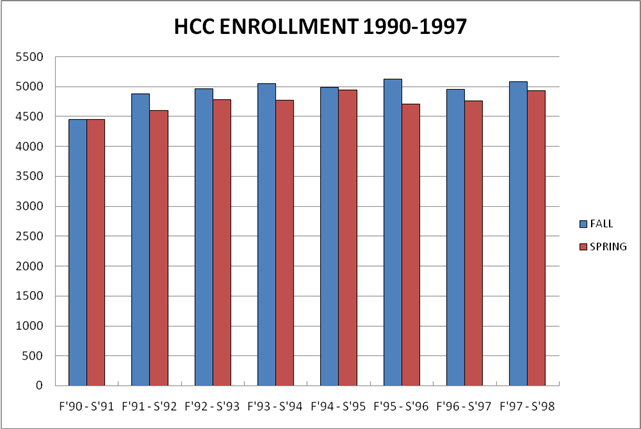
Appendix B

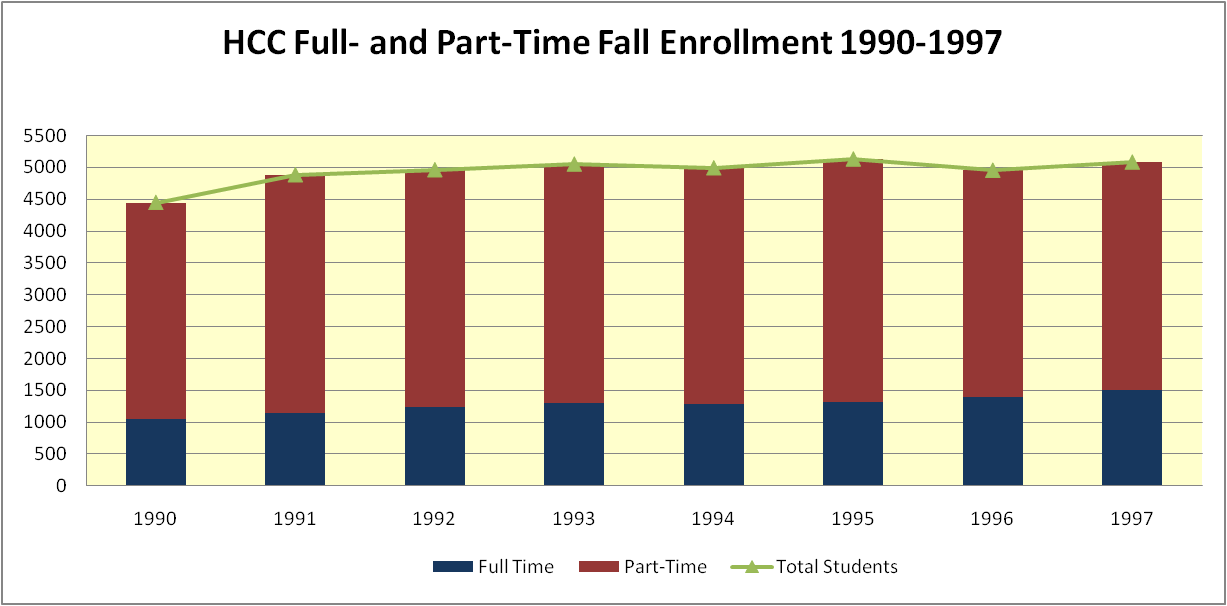
Appendix C
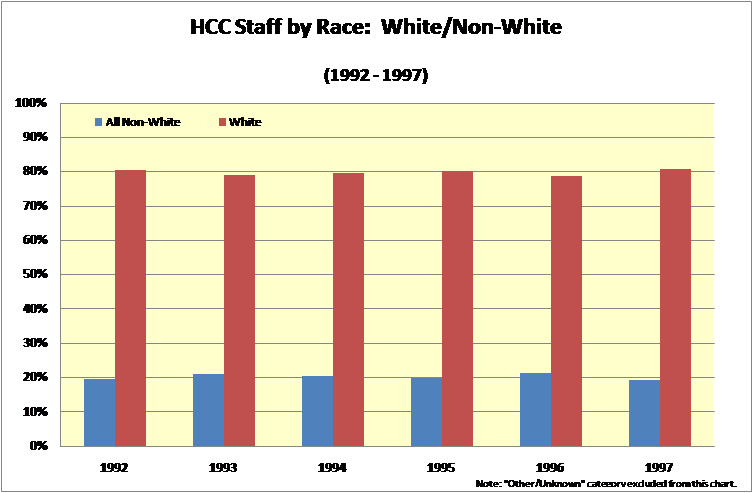
N.B.: Data for 1990 and 1991 were not available.
Appendix D
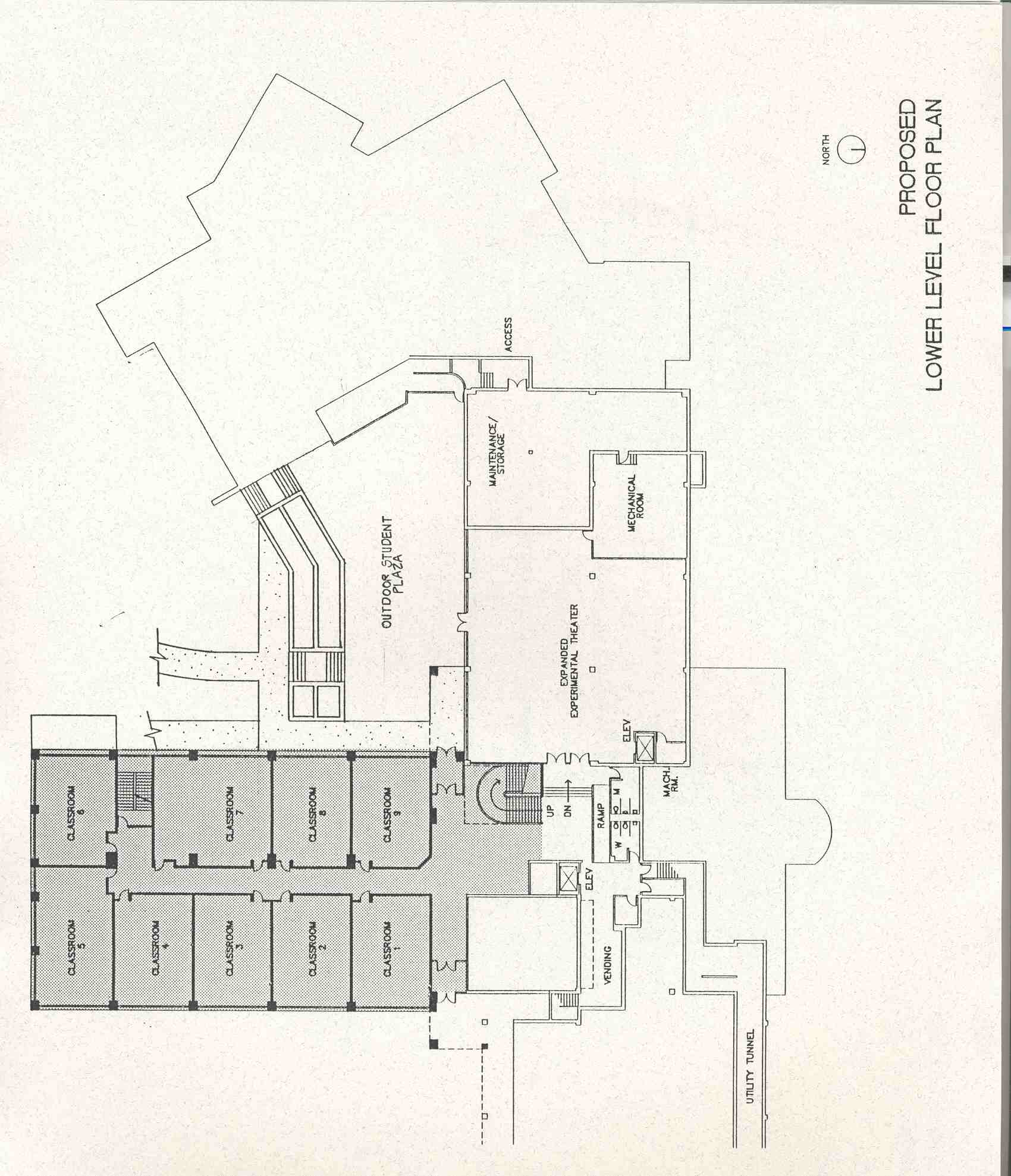
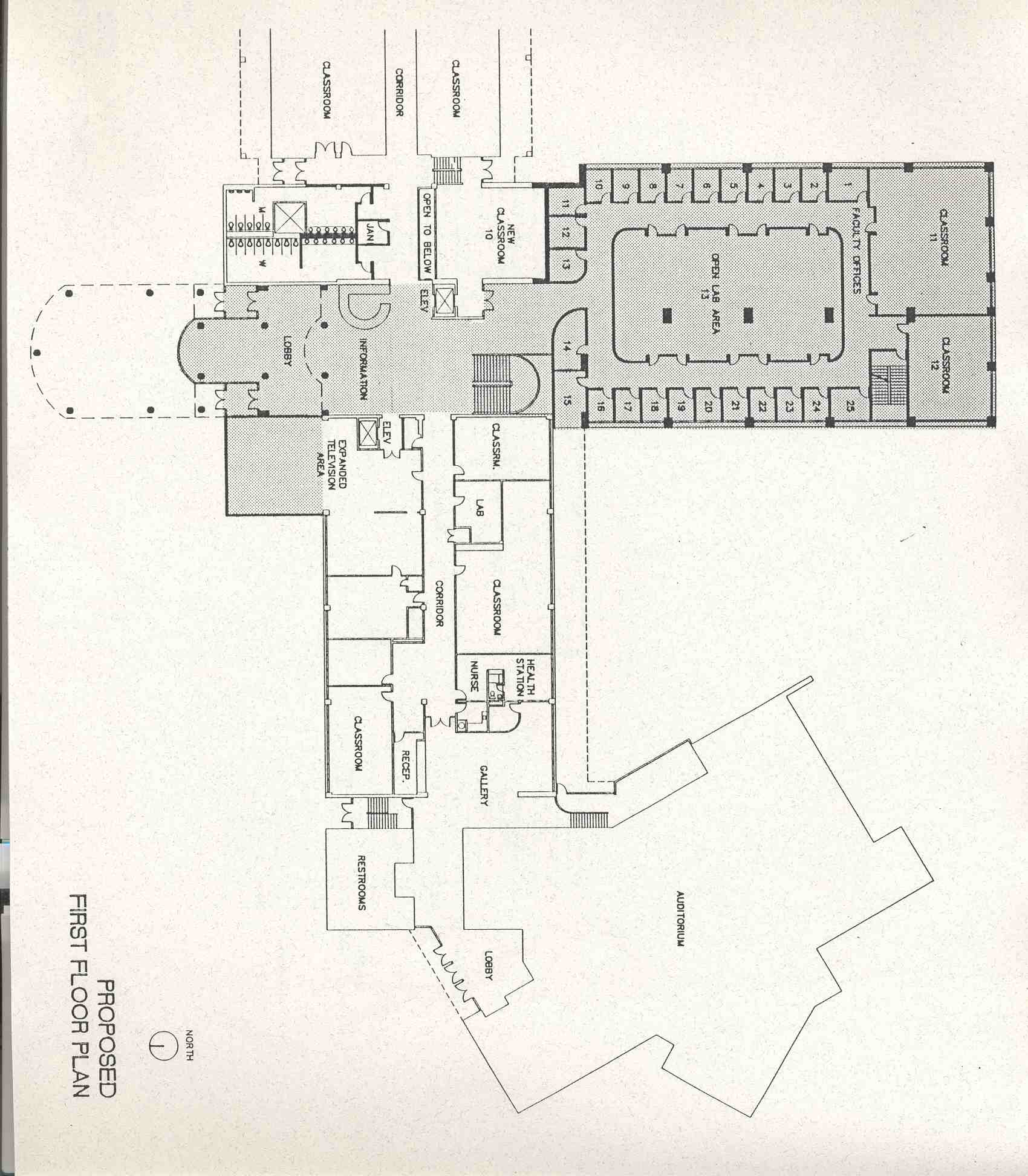
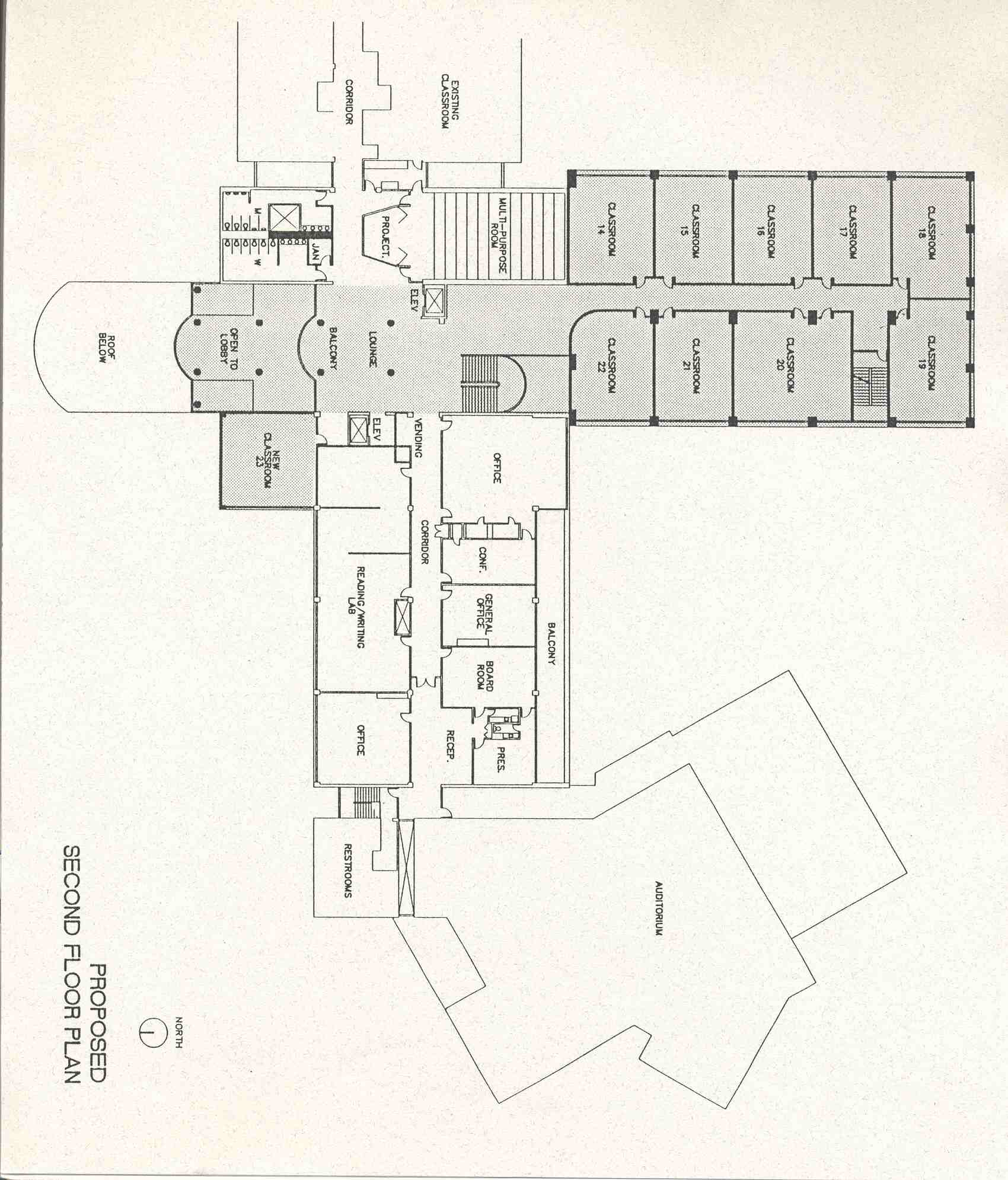
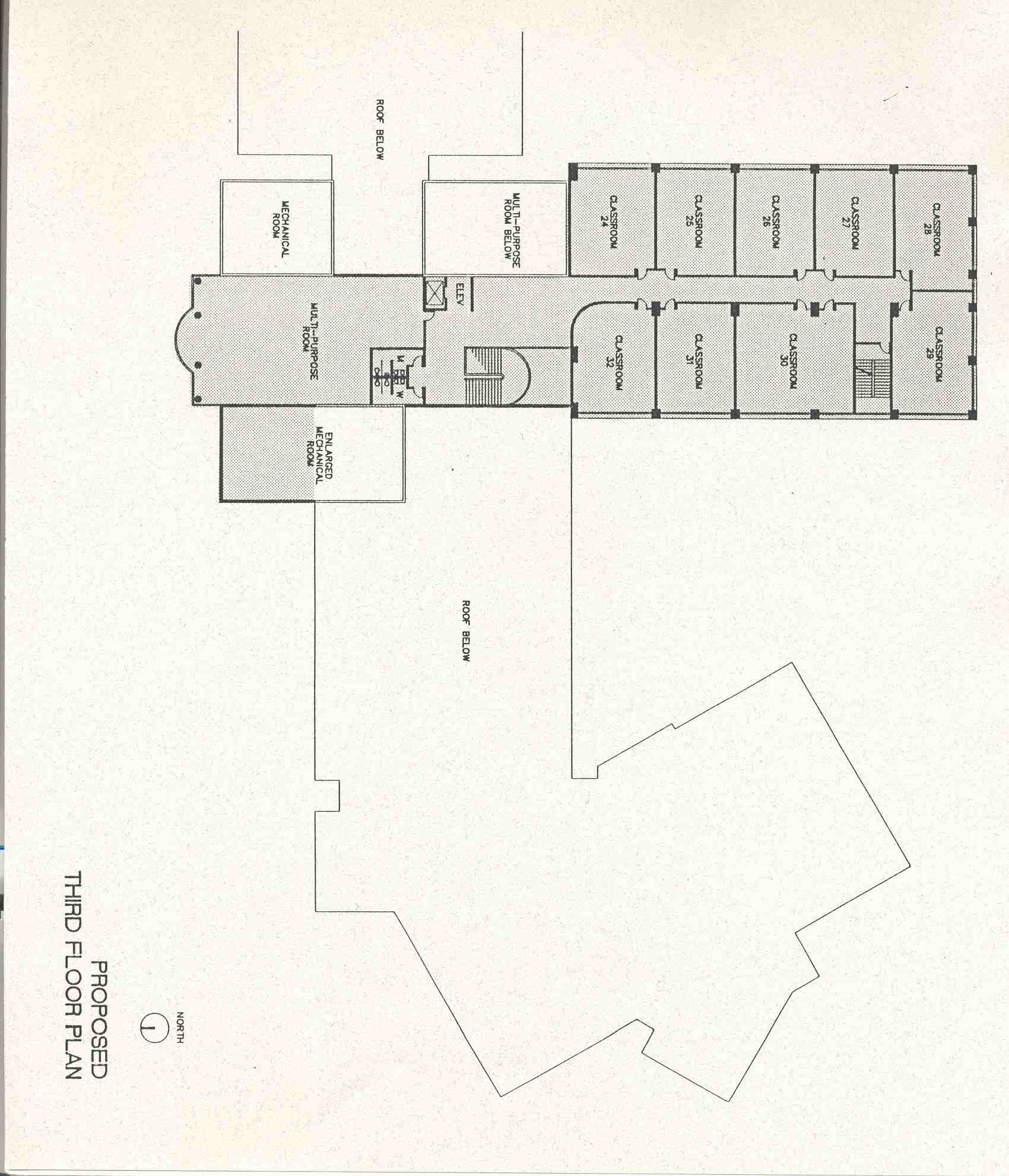
Appendix E
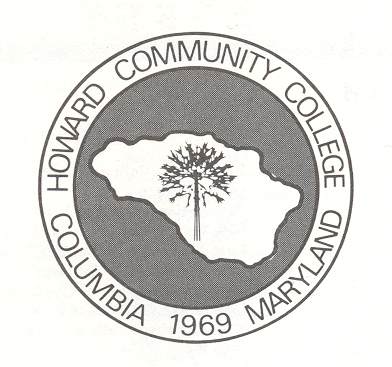
The Original HCC Logo

The 1994 Logo

The 1999 Logo
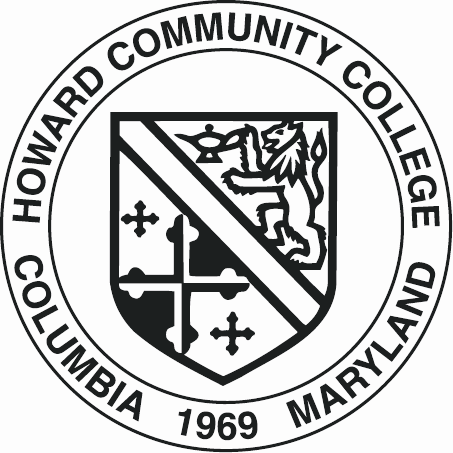
The Registrar’s Emblem
Appendix F
Organizational Chart ‡
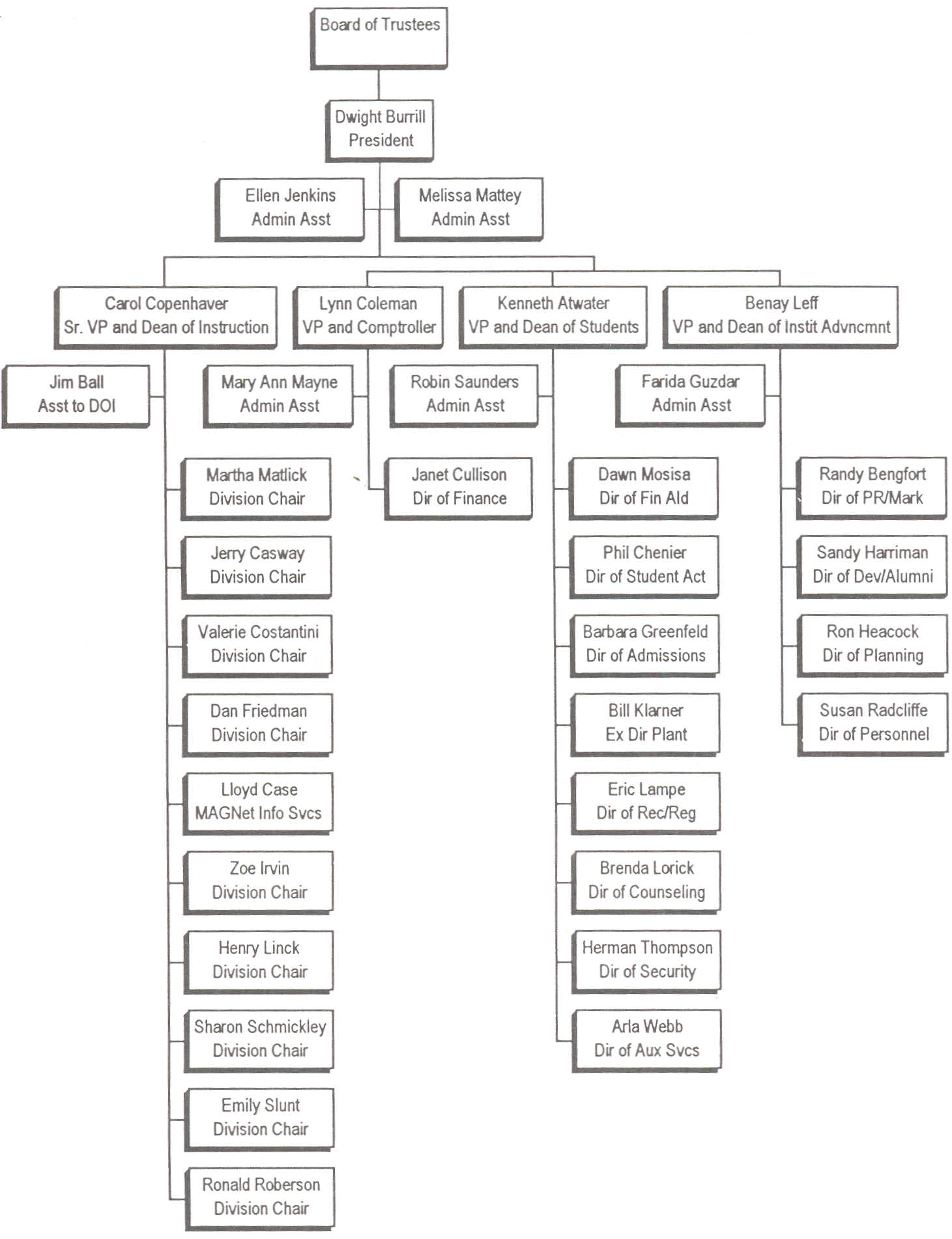
[*] This title appears in the August 1993 issue of On the “QT,” however in the college catalog for that year Kelly’s title is simply “Vice President”.
[†] This includes Glen Elg Country School.
[‡] There is an error in this organization chart. It does not show Continuing Education. This division was part of the Instructional area.
[1] Maryland Department of Economic and Community Development, Howard County, Maryland, 1985, Vol. 2.
[2] Maryland Department of Planning, Planning Data Services, Howard County, Revised, September, 2000.
[3] B. Livieratos memo to V. Marinich, October 19, 2009.
[4] Howard Community College 1990 Census of Population for Howard County, Maryland. Research Report Number
75, July, 1992, p. 7.
[5] Howard Community College Alumni News, February, 1990, pp. 1, 3.
[6] Howard Community College Campus News, October, 1990, p.4.
[7] Memo from Peter C. Ku, VP and Dean of Instruction to All Full-time Faculty, May 2, 1990.
[8] Memo from Peter C. Ku, VP and Dean of Instruction to FES/Promotion Committee, July 2, 1990.
[9] Barbara Livieratos, “Employers Pleased with HCC Grads,” Alumni News, Vol. 2, No. 1, January, 1991, p.1.
[10]Howard Community College Campus News, December-January 1990-91, p.2.
[11] Howard Community College Board of Trustees Minutes, November 20, 1991.
[12] Howard Community College Board of Trustees Minutes, May 8, 1991.
[13] “Analysis: Classroom Addition.” D.R. Brasher, Architects. The document is not dated, however, there is a penciled- in date of Sept. 1991.
[14] Howard Community College Board of Trustees Minutes, March 27, 1991, p.1.
[15] Idem., p.1.
[16] Idem. P.1.
[17] Washington Post, “Meet the Beeper People.” Thursday July 16, 1992, pp. 9-13.
[18] Howard Community College Board of Trustees Minutes, February 24, 1993, p.1.
[19] HCC Alumni News, Spring, 1992, p.2.
[20] Howard Community College Board of Trustees Minutes, January 22, 1992, p.3.
[21] Howard Community College Board of Trustees Minutes, February 19, 1992, p.1.
[22] R. Bengfort E-mail to V. Marinich, April 26, 2010.
[23] R. Bengfort conversation with V. Marinich, April 26, 2010.
[24] Howard Community College Board of Trustees Minutes, February 19, 1992, p.1.
[25] Howard Community College Board of Trustees Minutes, May 13, 1992, p.3.
[26] Birnbaum, Robert. Management Fads in Higher Education. San Francisco, Calif.: Jossey-Bass, Inc., 200, p.94.
[27]Ibid., pp.94-95.
[28] Ibid., p.100.
[29] Howard Community College Board of Trustees Minutes, January 27, 1993, p.1.
[30] On the “QT”, Vol. 1, Issue 1, August, 1993,p.1.
[31] Idem.
[32] Haecock, Ronald. A Proposal for Continuous Quality Improvement at Howard Community College. Novemebr, 1994, p.1.
[33] V. Marinich interview with Valerie Lash, May 13, 2008, p.9.
[34] Idem.
[35] V. Marinich conversation with J. Casway, May 11, 2010.
[36] Howard Community College Board of Trustees Minutes, September 22, 1993, p.2.
[37] Howard Community Colleg e Board of Trustees Minutes, December 1, 1993, p.2.
[38] Columbia; a Celebration. Columbia, Md., Perry Publishing, 1995, p.118.
[39] The spring 1993 student credit enrollment was 4,789, whereas the spring 1994 was 4,768
[40] Haecock, Op.Cit., p.11.
[41] V. Marinich interview with Dr. Dwight Burrill.
[42] Howard Community College Faculty Handbook, 1994, p. 53.
[43] For a detailed description of the “systems approach” see Marinich’s A History of Howard Community College; the Early Years, Up to 1981, pp. 21-24.
[44] Howard Community College Board of Trustees Minutes, June 8, 1994, p. 2. N.B. The bold type for the word “senior” is in the Board minutes.
[45] Howard Community College Board of Trustees Minutes, May 11, 1994, p.2.
[46] Howard Community College Board of Trustees Minutes, January 23, 1996, p.1.
[47] Ibid., p.2.
[48] Howard Community College Board of Trustees Minutes, October 23, 1996.
[49] H. Mitchell Email memo to V. Marinich, May 8, 2010.
[50] “As Burrill era ends, college seeks new leader.” The Columbia Flier, July 31, 1997, p.25.
[51] Howard Community College Catalog, 1997 -1998.
[52] V. Marinich telephone interview with Benay Leff, June 27, 2010.
[53] “Trends in Characteristics of Non-Credit Students.” Office of Planning, Research and Organizational Planning, April 2, 2001.
[54] V. Marinich interview with Roger Caplan, September 18, 2009.
[55] The Columbia Flier, July 31, 1997, p.25.
[56] V. Marinich interview with Joan Athen.
[57] The Washington Post; Howard Weekly. July 31, 1997.
